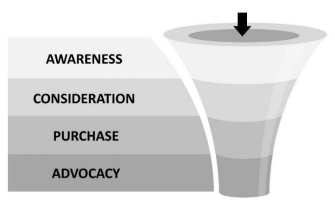
What is evident is that technology has changed the way customers buy. However, before we delve deeper, let us first understand the typical customer journey of someone who is purchasing a product or service, regardless of whether it is a B2B, B2C, offline or online business.
Businesses need to evolve to adapt to changing customer behaviour brought about by the digitally evolving world. The traditional customer journey has been disrupted and although most companies know how crucial it is to evolve with technology and create digital processes and solutions, successfully implementing them is a different story. Regardless of the nature or set-up of the business, the most basic customer journey sees the customer go through four stages: awareness, consideration, purchase and advocacy.
The journey can be represented as what is known as a sales funnel.

Sales funnel. Image Credit: J C Sum
Awareness
In the awareness stage, the prospective buyer learns about your product or service through exposure to your brand. This could have been through traditional marketing efforts like word of mouth, referrals, newspaper, magazine, television or radio advertisement, event participation and flyers.
Or, in today’s digitally evolving world, the prospect might become aware of your brand through a Google search, a photo posted on Instagram by someone they follow, a sponsored story on their Facebook feed or a targeted email you sent to them through an email list.
Also Read: The essentials of mapping a customer journey across digital assets
The hope is that with awareness comes interest, and the prospect is curious to learn more about your product by visiting your website or heading down to your retail store. By creating awareness, you are starting a relationship with the prospect. The more the prospect gets to know you, the more likely the prospect will buy from you. If you push your product or service from the beginning, you will turn off prospects and chase them away.
The goal here is to establish your expertise, offer to help them in any way you can and move the prospect from the ‘awareness’ stage to ‘consideration’ stage.
Consideration
At this stage, the prospect is evaluating whether she wants to buy your product or service.
She might also be considering other options, including competitor products or even the DIY route.
The prospect will be gathering as much information as she can by scouring your website to read product descriptions or watch demo videos, looking for online reviews, following you on social media or asking friends or family for opinions.
Well-timed attractive offers such as free shipping, a discount, bonus product, money-back guarantee or a 1-year warranty can tip the scales in your favour and convince the prospect to buy your product. Social proof like testimonials and reviews posted on a social media platform will also contribute to the decision-making process.
Purchase
At this stage, the prospect is becoming a customer by finalising the deal with you.
The purchase is formalised by signing a contract or clicking the ‘buy’ button. And, of course, making payment.
The customer’s journey should not end after making the purchase. You will want to move her from being a customer to be an advocate (supporter and evangelist of your brand).
Also Read: Two babies and US$45M Series A in tow: A female entrepreneur’s journey to dominating the global payroll industry
Advocacy
Advocacy is the stage where the customer is retained, and brand loyalty is built so that she comes back as a returning customer and skips the ‘awareness”’ or even ‘consideration’ stages and moves straight to ‘purchase’.
Your after-sales service programme and post-purchase marketing efforts are designed to keep her stay engaged with your brand. You want to focus on keeping her happy so that she returns as a repeat customer and becomes a brand advocate. Word of mouth is a powerful force, and no one can do it better than a happy customer.
Of course, this assumes your product or service solves the customer’s problem or fulfils her needs.
THE EVOLUTION OF THE CUSTOMER JOURNEY (SALES FUNNEL)
Once you understand the journey of your customer, you must map out the typical journey for your business and how your business is set-up to attend to a customer’s needs at different stages of the journey.
Also, if you are an existing business, think about how different the customer journey was before and after the world digitally evolved. If your business is new, think of how your own buying journey has changed over time when buying a product such as a new pair of shoes, smartphone or insurance plan.
Let us have a look at two scenarios to put things into perspective.
Imagine that a customer wants to buy a vacuum cleaner soon as hers is starting to give problems. She does not have an immediate need for it but changing vacuum cleaners is on her mind.
The Customer Journey (Pre-digital Age)
Traditionally, a customer’s journey may look something like this:
Awareness
Annie first learns about the new Acme Appliances vacuum cleaner through an advertisement in the newspaper. The next day, she hears an advertisement on the new vacuum cleaner on the radio.
Consideration
Annie calls up the telephone number that was promoted in the advertisements and is invited to come down to the Acme Appliances store nearest to her for a demonstration.
Also Read: Collaborate to innovate: New age mantra for creating a sustainable startup journey
She heads down to the store and is introduced to a salesperson who explains all the new features of the vacuum cleaner, gives her a brochure and demos the product to show how silent and effective it is. Annie asks to see if other models or options are available. She even goes to another store nearby to compare similar products and prices.
Purchase
After looking at the options and evaluating the different features, the customer decides to buy the Acme vacuum cleaner. She fills in her information on an order form and makes payment.
Advocacy
Annie brings the vacuum cleaner home to use it and is happy with the purchase. She tells her friend about the Acme vacuum cleaner and recommends it as a worthwhile purchase.
A month later, the customer gets a printed brochure in the mail highlighting a new attachment for the vacuum cleaner that will be released soon. She is also reminded that she can bring in her vacuum cleaner for free servicing in six months.
The Customer Journey (Current)
Now, consider the customer’s journey for the same product today.
Awareness
Twenty years ago, Annie bought an Acme Appliances vacuum cleaner that served her well. Several years later, she bought an identical replacement, but now she needs a new vacuum cleaner, and Acme Appliances is no longer in business.
So, Annie does a Google search on the latest and most popular vacuum cleaner. She comes across the new vacuum cleaner from Stark Enterprises in several search results. Clicking the various links, she learns more about the product, its features and benefits.
Also Read: Why fintech companies should learn about customer retention from e-commerce companies
Consideration
After doing some online research, Annie narrows down her choices to the Stark vacuum cleaner and a competitor’s model made by Wayne Industries.
She does more research by watching reviews of both vacuum cleaners on YouTube and reading reviews on blogs. She also checks the ratings on popular online marketplaces. As she is re-reading the information on the Stark vacuum cleaner product page, a pop-out window opens at the bottom of her screen letting her know that a Sue from Mont Kiara had purchased the same product one day ago.
After comparing offerings from both brands, she decides to buy the Stark vacuum cleaner. While the features are similar to the Wayne model, she was attracted by Stark’s three-year warranty, free shipping and bonus dust-trap device that came with the purchase.
Purchase
Annie clicks on the “buy now” button, fills in her order info and makes payment through PayPal. She receives an order receipt in her inbox that informs her that the product will be delivered within five days.
Advocacy
A week later, a courier delivers the Stark vacuum cleaner. Annie tries it out for the first time and is happy with the results.
She takes a photo of the vacuum cleaner with her clean living room in the background, adds a filter and posts it onto her Instagram account, which is automatically shared on her Facebook account. She adds the hashtag #starkvacuumcleaner with a short positive review. Her post gets 29 likes, two shares and eight comments, one from Stark Enterprises community manager.
Also Read: Why reciprocity is key to building deep customer relationships
A day later, Annie receives an email thanking her for her purchase. She is given a referral code and the email states that if she shares the code with her friends or on social media, she will receive a US$20 voucher each time someone buys a Stark Vacuum Cleaner with her referral code. Every month, she also receives an email on tips on how to maintain the Stark Vacuum Cleaner and suggestions on how to keep an apartment dust-free.
I am sure you can relate to Annie’s customer journey that takes place in today’s digitally evolving world. If you are above the age of 35, you probably can relate to Annie’s journey from two decades ago.
While the scenarios given were for a B2C order, many B2B customers would follow a similar journey. If not, the experience would be a hybrid of both scenarios.
The fact is, the customer journey has changed and will continue to change as the world evolves digitally.
—
This story has been excerpted by courtesy of the publisher from Evolve, Adapt or Collapse by J C Sum (Evolve&Adapt, 2020).
To purchase the book, please visit this site.
Image Credit: Cam Morin on Unsplash
The post Book Excerpt: In this digital age, customer journey as we know it may no longer exist appeared first on e27.